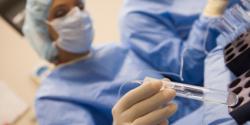IVF in Israel

Artificial insemination treatment in Israel consistently enjoys excellent success rates (around 60%). About 15 thousand IVF cycles are performed in various Israeli clinics every year.
Statistically, 10 to 15 percent of couples who want to conceive a child face difficulties. This group includes couples suffering from clear medical problems, as well as healthy couples attempting to conceive for a year without results. The IVF treatment in Israel successfully resolves about 90% of these cases.
IVF is a process of in vitro fertilization of ovarian egg by a sperm. This process consists of eggs' removal from fallopian tubes, fertilization and insertion of fertilized eggs into the uterus. Initially, IVF was performed without hormonal stimulation, according to a woman's natural menstrual cycle. The first child, after successful IVF treatment, was born in England on July 25, 1978. The girl's name was Louise Brown; Professor Robert Edwards was her "medical father". He won the Nobel Prize in Physiology and Medicine in 2010, aged 85 years, for developing the IVF procedure.
Over the years, scientists have repeatedly improved the methods of artificial insemination. The most significant advance in this area is known as "micromanipulation", which combines several techniques currently used for artificial insemination. One of these techniques is ICSI - introduction of sperm into the cytoplasm of the egg. This method was developed in Belgium, in the early 90's, however first positive fertilization results using ICSI have been achieved in Israel. ICSI radically expanded the possibilities of IVF, solving the problem of male infertility. In many cases, the male semen hasn't got enough sperm for fertilization, or there is a defect in the semen's structure and ability to penetrate the egg. ICSI allows solving about 90% of those problems. Israeli doctors are able to help even those men whose ejaculation contains no sperm – sperm is extracted directly from testicular tissue, a few sperm cells are sufficient for fertilization of an egg.
Preliminary diagnosis is another method, which was first successfully applied in Israel. Usually, implantation of an embryo into a uterus is performed on the second or third day after fertilization, but with IVF an embryo can grow extracorporeally for up to 6 days.
On the third day of development, an embryo consists of eight cells; at this stage it is possible to take one or two cells for genetic testing. Under the microscope, the transparent sheath of a fertilized egg is punctured by a laser beam, then a microscopic tube is inserted into it and 2 cells are sucked out, whereas the remaining 6 cells remain intact and continue their division. This method allows identification of genetic abnormalities, hereditary disease of the nervous system; count the number of chromosomes for the diagnosis such disease as Down's syndrome, etc. If on the sixth day of embryonic development the embryo cannot "hatch" from the egg shell for lack of enzymes, or because of the shell's high density or thickness, then the shell can be artificially split by a laser beam. This micromanipulation is called "assisted hatching."
Today, Israel is the world's IVF capital. Just one medical center, Assuta, performs about 5,000 IVF procedures a year. More than 4% of all newborns in Israel are born as a result of the IVF treatment, while in America the figure is only 1%.
A great number of patients, with various medical problems, provide strong basis for successful research and development of artificial insemination in Israel.















